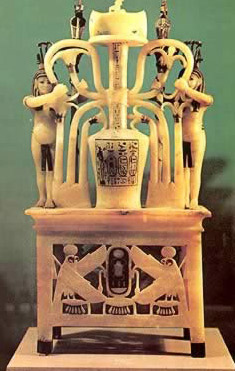Alabaster perfume vase from King Tut’s tomb. Via touregypt.net.
Original description says:
Another object found between the two outer shrines was this perfume vase, made of four pieces of alabaster cemented together. The idea conveyed by its symbolism is that the Nile will provide the king and queen, whose names are inscribed on the vase, with its contents. The vulture with the so-called atef crown on its head represents either Mut or Nekhbet protecting the perfume. Flanking the vase are two deities with pendulous breasts and potbellies, both named Hapi, who personify the Nile and its fertility. They are differentiated by the lily and papyrus clusters on their heads as Hapi of Upper Egypt and Hapi of Lower Egypt.
The two divisions of the country and its Nile are further symbolized by the lily and papyrus stems tied to the neck of the vase and held by the two Hapis, each of whom also supports a column representing a single stem and flower of one of the same plants, surmounted by a cobra wearing the crown of Upper and Lower Egypt. In the openwork panels of the stand beneath the vase are figures of falcons with solar disks mounted on the hieroglyphic sign for “gold”, protecting with their outspread wings the cartouches inscribed with the king’s names and flanked by scepters which symbolize “dominion”. The piece is embellished with gold and painted ivory.








